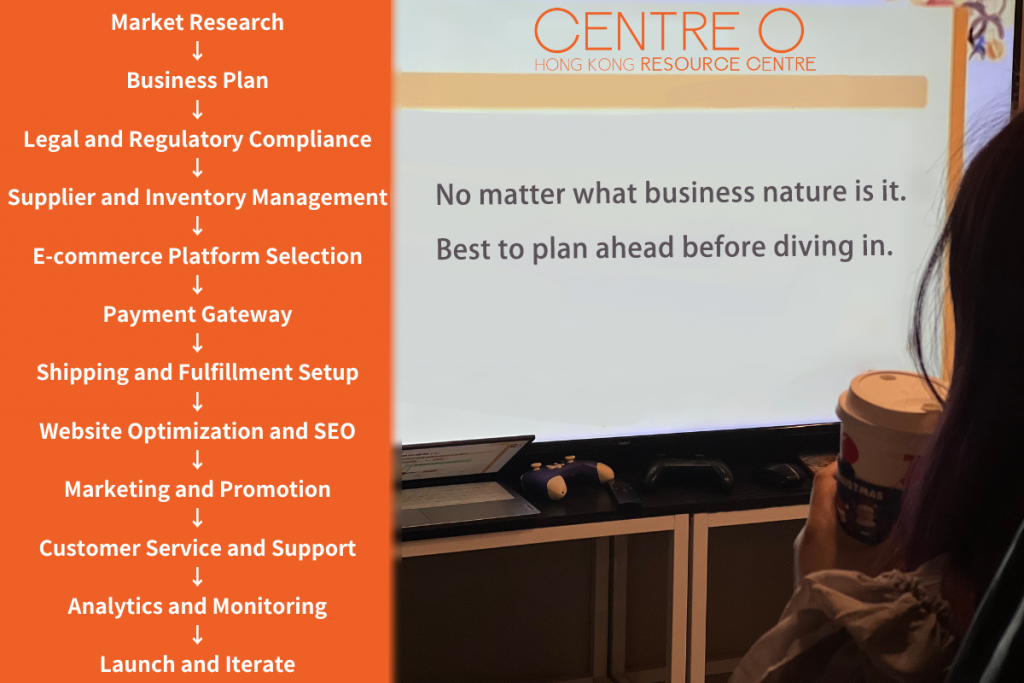
Centre O prepared a flowchart to let you know the key steps involved in setting up an e-commerce business. No matter what business you want to start, you have to plan well before diving into anything. Also, you have to outline the key steps and the process into sequence. In order to have a clearer picture of your process and the checkpoint. Now, we at
Market Research
Conducting market research then you can identify your target market and audience. And you can find out your competitors and industry trends. And then you can determine your own product or niche market.
Business Plan
You have to define your business objectives and goals via develop a business model. For instance, dropshipping, wholesaling or private labeling. Then you have to create a budget and financial forecast.
Legal and Regulatory Compliance
Once you can identify your business market and have a plan. Then you have to register your business entity. It can be a sole proprietorship or limited company. When you company is incorporated. You have to obtain all necessary permits and licenses. Then, set up the tax ID and company business bank account.
Supplier and Inventory Management
When your company is officially set up. Then you can source suppliers or manufacturers for products. Also, establish relationships and negotiate agreement’s term and condition. And then you have to determine inventory management system. For example: in-house or dropshipping.
E-commerce Platform Selection
You have to choose your best fit e-commerce platform such as Shopify, WooCommerce or Magento etc. Then you can customize the website design and layout to differentiate your brand and product. And then setting up product categories, listings and pricing.
Payment Gateway
Select and set up a payment gateway is very important. For example, PayPal, Stripe, Square etc. No matter which payment gateway, it involves a service fee. On the one hand, you can think of the easiness to transfer to your company bank account. On the other hand, you have to integrate secure checkout for your customers. Then ensure you are stand with compliance of The Payment Card Industry Data Security Standard.
Shipping and Fulfillment Setup
As you are e-commerce, you are not expecting customers to pick up the merchandise from you directly. Then you need to determine shipping carriers and methods. For example, international shipping companies, local couriers or post office service. Then you need to check and set the shipping rates and policies. And the rates and policies have to show on your platform. Finally, make sure the customer’s order can implement fulfillment process.
Website Optimization and SEO
No matter how good is your product, if your potential customer cannot find you easily. So, before you launch your e-shop. You have to optimize your website search engines (SEO). Or the website experience is not good. Then, you are unable to keep your customer, too. Thus, you have to create high-quality product descriptions and images to let customer clearly understand your products. Furthermore, prepare and implement content marketing strategies.
Marketing and Promotion
You can promote your product via social media. It is one of the lowest cost marketing plans. Then you can launch advertising campaign via Google Ads, Facebook Ads etc to draw more attention. Also offers time limited promotion offers, discount and the loyalty programmes definitely can be a good promotion too.
Customer Service and Support
Good customer support is always helping you to gain customers. So it is important to set up a customer service channels via live chat, email or phone. Your website should provide clear policies of returns, refunds, and exchanges. The clear policies can avoid any conflict.
Analytics and Monitoring
You can install analytics tool such as Google Analytics to track website traffic and performance. The tool also can analyze the key metrics for example conversion rate, average order value. The report can assist you know your business better and reflect the real situation of your operation. In the very beginning, it seems not too much data, but it will be very useful to make data-driven decisions to optimize your business operation.
Launch and Iterate
When everything is ready, then you can launch e-commerce website and start selling products. It is very important to maintain a good customer service. As the customer service can monitor the customer feedback and reviews. No matter it is relating to the product itself, their shopping experience. All the feedback is helping you to maintain a better image.
Depending on the specific nature of your business and industry, you may need to customize and expand upon these steps accordingly. The flowchart mentioned steps is the general overview. Additionally, seeking advice from professionals such as legal advisors, accountants, and e-commerce consultants can help ensure a smooth and successful setup process.
For the further information, please contact us.
You may want to read: THE NITTY GRITTY OF SETTING UP A BUSINESS IN HONG KONG